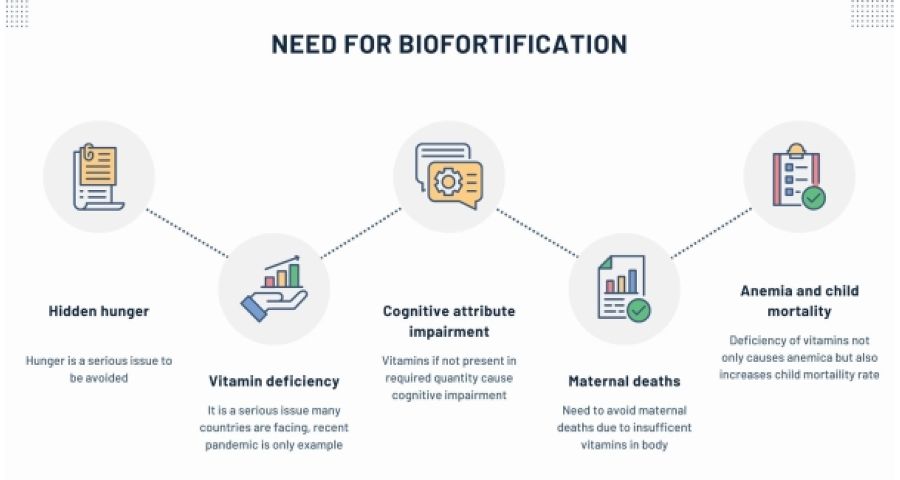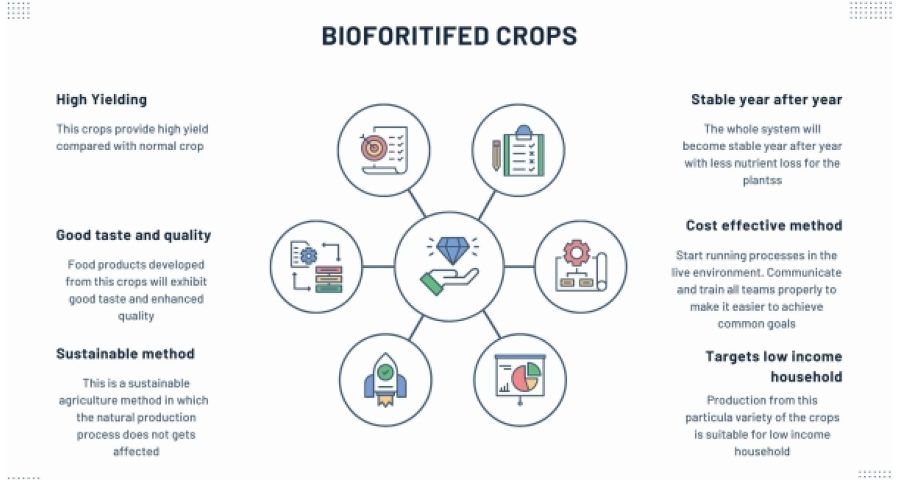Introduction
Ending all forms of hunger by 2030, as outlined in the United Nations' second Sustainable Development Goal (UN-SDG2), is a challenging but necessary endeavour, given the current state of the world's food supply, the poor global health status, the limited time left, and the socioeconomic consequences of hunger. A study by Srivastav et al (2022) reveals that until now, the primary goals of our agricultural system have been to boost crop productivity and grain yield, and a little to addressing human health. This strategy has inadvertently resulted in reduction of some micronutrients in dietary grains, and gradual increase in nutrient deficiencies among consumers.
Micronutrient malnutrition, also known as "hidden hunger," has a negative impact on the health of millions of people worldwide. A recently published study in The Lancet by Global Alliance for Improved Nutrition (GAIN) and Micronutrient Forum shows that 1 in 2 children and 2 in 3 women worldwide are affected by micronutrient deficiencies. Its health consequences which include stunting, impaired vision, anaemia, and even death place a consequential burden on people in low- and middle-income countries (LMICs) who cannot afford or do not have access to healthy and diverse diets.
As a result, several strategies for combating malnutrition have been proposed by FAO and these include dietary improvement, including increased production and consumption of micronutrient-rich foods; food fortification; supplementation; and global public health and other disease control measures. Biofortification is a process that increases the nutrient content of plants during their vegetative life cycle.
Biofortification: A Food Systems Solution
Simply put, biofortification is the process of growing food crops to increase their nutritional value. It is part of a food systems approach to address hidden hunger. Biofortified crop varieties are those which have been nutritionally enhanced using conventional plant breeding techniques. The process increases the micronutrient content of staple crops to the levels required for enhancing human nutrition for low-resource populations in LMICS without compromising yield or farmer-preferred agronomic features.
Globally, biofortification projects primarily focus on increasing iron, zinc, and provitamin A carotenoid levels in various food crops. They are essential for human health. Anaemia, or reduction in haemoglobin levels in the blood, is caused by iron shortage and impacts cognitive development, growth, and physical fitness. A lack of Zinc impairs the immune system, raises the chance of contracting infectious diseases and can harm a developing child, both during pregnancy and after birth. A healthy immune system and good eyesight depend on vitamin A, the lack of which raises the risk of blindness, contributes to anaemia development, and is linked to higher rates of infection and infant death.

Recent nutritional studies show that biofortification supplements existing strategies, such as food supplementation and industrial fortification, which are insufficient to eliminate micronutrient deficiencies on their own. Over the years many researchers and their collaborators have proven that this plant-breeding-based approach to alleviating vitamin deficits in agriculture is effective. Srivastav et al (2022) showed that more than twenty million farm households in developing nations already cultivate and consume biofortified foods. The ultimate nutrition goal is that everyone has access to an affordable, diversified healthy diet. Biofortification contributes to this goal by ensuring that staple crop component of this diet is as nutritious as possible. The main beneficiaries of biofortification are women and children, whose needs are particularly high and frequently unmet.
Benefits of Biofortification
- Biofortification is targeted primarily to the rural poor who rely heavily on locally produced staple foods such as Maize, Rice, Beans, Cassava, Potatoes and Millet as their primary source of nutrition.
- Biofortification reaches the most vulnerable population who often have restricted financial or market access to commercially processed fortified foods.
- Biofortification is a sustainable strategy; The natural production process in agriculture does not get affected.
- Biofortification produces higher yields in an environmentally friendly way.
Best Practices and Innovation
- Biofortification breeding has necessitated the development or adaptation of cost-effective and rapid high analytical techniques for micronutrients, such as testing the mineral or vitamin contents of thousands of samples per season.
- Private agriculture research institutes, government authorities and agri-based firms are investing in public health program to provide biofortified crops to the undernourished people is also heightening the overall demand for biofortification market.
- The strong advancements in the agricultural sector, rising implementation of biofortification in crops such as beans, wheat, sweet potato, rice, corn and pearl millet, sorghum, barley also serves as foremost drivers for increasing the demand for biofortification market at a global level.

You might also be interested in:
- Bridging Micronutritent Gaps through Fortification
- New Estimates:1 in 2 Children and 2 in 3 Women Globally Affected by Micronutrient Deficiencies
- 50 Nutrition and Child Health Organisations Support Important WHO Initiative on Food Fortification
- Challenges to Establish Effective Public-Private Partnerships to Address Malnutrition in All Its Forms